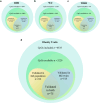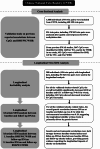Longitudinal changes in the genetic and environmental influences on DNA methylation linked to obesity measures: a 5-year twin study
- PMID: 41182460
- PMCID: PMC12583361
- DOI: 10.1186/s43556-025-00334-y
Longitudinal changes in the genetic and environmental influences on DNA methylation linked to obesity measures: a 5-year twin study
Abstract
The reproducibility of obesity-related DNA methylation (DNAm) sites (CpGs) remains low across studies, and the underlying mechanisms involving genetic and environmental contributions require further investigation. In this study, we systematically searched PubMed, EMBASE, and EWAS catalogue for CpGs associated with BMI, waist circumference (WC), and waist-to-hip ratio (WHR) from previous publications, identifying 29 studies with 2,603/892/28 CpGs for BMI/WC/WHR, respectively. Then, based on 1,074 twins from Chinese National Twin Registry, 493/149/8 CpGs were validated for BMI/WC/WHR, controlling for genetic factors. Following this, within the full twin population and a subsample of 308 twins with longitudinal data collected over a 5-year period, structural equation models (SEMs) were used to assess the heritability of CpGs and how it changes over time. The overall heritability of these obesity-related CpGs was relatively high, averaging 0.34 in full twin population, which decreased from 0.38 at baseline to 0.31 at follow-up. Bivariate SEMs were employed to investigate the genetic/environmental effects behind the longitudinal stability of DNAm. Genetic correlations between baseline and follow-up DNAm levels were high (mean = 0.74), whereas environmental correlations were relatively low (mean = 0.19), suggesting the role of genetic influence on the stability of DNAm at these CpGs. For longitudinal cross-relationships between obesity indicators and DNAm, considerably higher genetic contributions from baseline obesity traits to follow-up DNAm (mean = 0.15) was observed, compared to the baseline DNAm's genetic influences on follow-up obesity indices (mean = 0.09, P < 0.01). These findings provide genetic evidence for obesity-related DNAm and demonstrate that the genetic effects of obesity have a persistent longitudinal influence on DNAm.
Keywords: DNA methylation; Genetic correlations; Longitudinal study; Obesity; Twin study.
© 2025. The Author(s).
Conflict of interest statement
Declarations. Ethics approval and consent to participate: This study was approved by the Biomedical Ethics Committee at Peking University, Beijing, China (IRB00001052-13022, IRB00001052-14021, IRB00001052-22032). Informed consent was obtained from all recruited participants. Consent for publication: The authors are consent to the submission and publication of this paper. Competing interests: The authors declare that they have no competing interests.
Figures







References
-
- Pan XF, Wang L, Pan A. Epidemiology and determinants of obesity in China. Lancet Diabetes Endocrinol. 2021;9(6):373–92. 10.1016/S2213-8587(21)00045-0. - PubMed
Publication types
MeSH terms
Grants and funding
LinkOut - more resources
Full Text Sources
Medical
